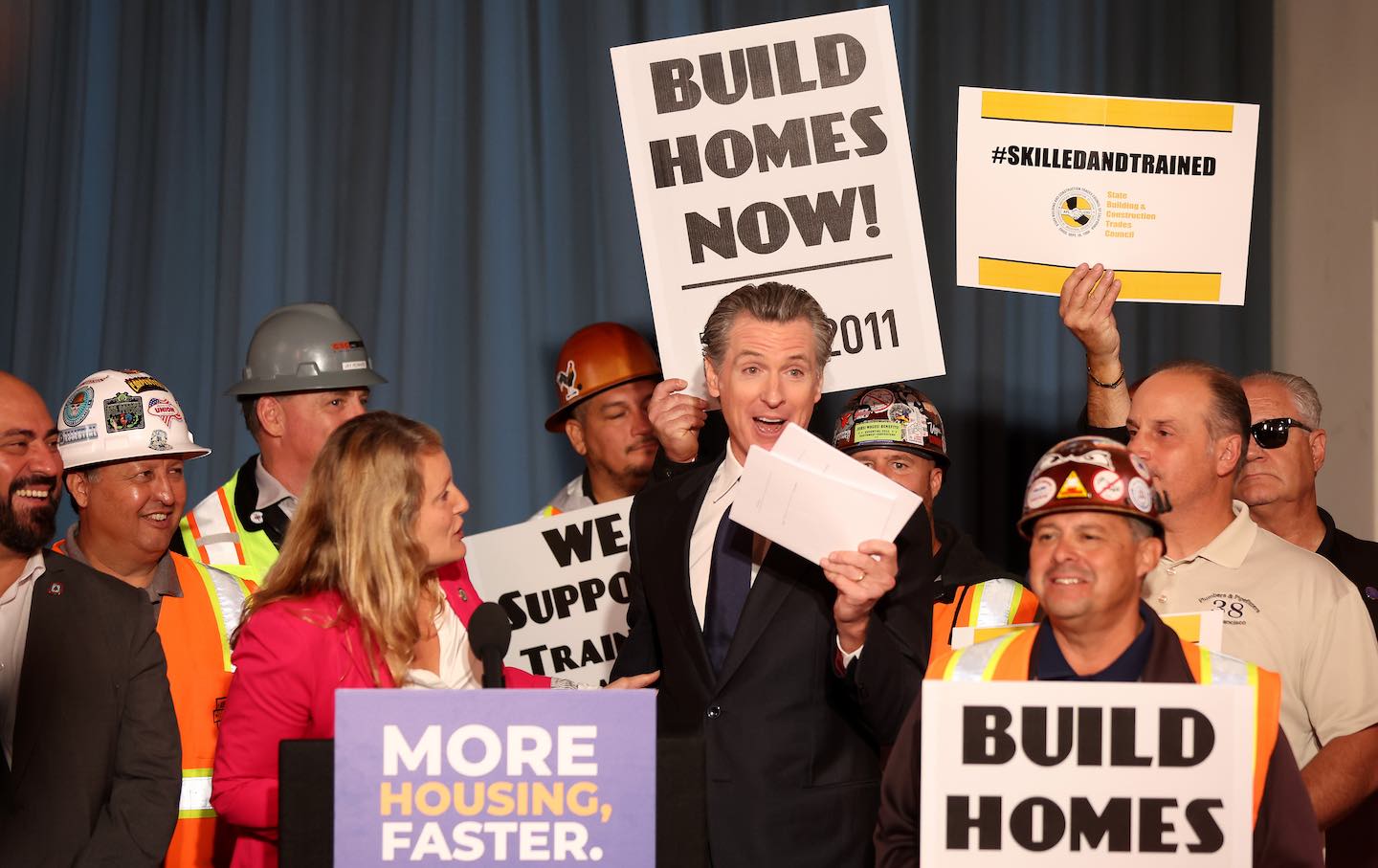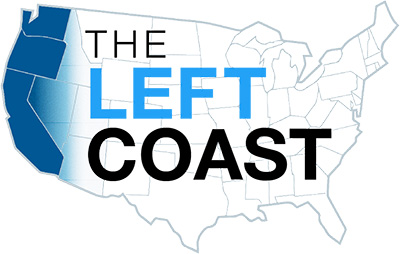
California Governor Gavin Newsom holding two housing bills that he will sign during a press conference on September 28, 2022, in San Francisco, Calif.(Justin Sullivan / Getty Images)

There’s a mad scramble underway in California this week as the state approaches its annual deadline for bills passed by the legislature to be signed or vetoed by the governor. At the start of the week, there were more than 500 bills awaiting Gavin Newsom’s attention, and lobby groups and activists were desperately waving their arms and stomping their feet in an effort to get Newsom to sign their particular favorites into law.
Two bills, SB6 and AB 2011, signed on Wednesday, open up vacant commercial land for the construction both of apartment blocks and single residence family homes. Affordable housing advocates have long argued that this reform is critical if California is to get a handle on its housing crisis. In the wake of the bill’s signing, a range of groups, from the SEIU in Los Angeles—which has pushed such a measure for years—to housing rights organizations in the Bay Area, celebrated its passage. The group Urban Footprint, which analyses city development trends, has calculated that these laws could ultimately lead to more than 2 million homes’ being built on upwards of 100,000 acres of commercial land over the coming years. It would be a massive increase in the housing stock that could go a long way to ameliorating a festering housing crisis that has been allowed to worsen in California year-on-year for the past several decades.
Newsom, whose first three years in office have been characterized by bold promises on housing followed by a grievous inability to follow through, is now playing a game of catch-up. He promised when elected to oversee the building of 3.5 million new homes in the state by 2025. Instead, new home construction has averaged roughly 120,000 per year. He promised to streamline the permitting and zoning process; instead, California’s NIMBYist housing tendencies and the rampant misuse of the California Environmental Quality Act by well-to-do homeowners to stymie nearby development projects have conspired to create ever-worse housing bottlenecks. As The Sacramento Bee noted this week, at this paltry rate of building, it will take the state 30 years to reach Newsom’s goals.
It’s a scandalous failure and one that Newsom knows could well sink his future presidential ambitions—unless he’s able, in what seems to be an all-but-certain second term as governor, to put the pedal to the metal on new housing, as well as supportive services for the unhoused mentally ill and drug-addicted populations. After all, any Republican—or, for that matter, Democrat—looking for visual imagery to spike Newsom’s national ambitions simply needs to show footage of the dismal shantytowns now dotting most every California city, and to point to the fact that the state has 160,000 homeless, 70 percent of whom are unsheltered. In 2022, more than half of all of the unsheltered homeless in America live in California. There’s no way to sugar-coat it; it’s a crescendoing calamity.
In the state capital of Sacramento, officials have, with much fanfare, been shutting down encampments in recent months. It makes for good political theater. In reality, however, the tents and cardboard and plywood dwellings are removed from one underpass and one main thoroughfare only to pop up a few hundred meters away a couple days later. At great financial cost, parks and shopping areas are cleaned up and “reclaimed” for housed residents to use, but within weeks, the unfathomable piles of dense garbage strewn along what are supposed to be public walkways, the beaten-up old cars and vans that people sleep in, and the open fires on which the tent-dwellers cook return.
At both the local and the state level, there seems to be almost no political stamina to stick with the problem long enough to provide real solutions. Point-in-time counts of the local homeless estimate somewhere in the region of 10,000 homeless in Sacramento County. Along the American River Parkway alone, thousands live in conditions at least as bad as those seen in many refugee camps: almost no access to safe drinking water, no toilets, and precious little security or safety. The county recently moved to ban encampments along the parkway, but it will be a hard slog to enforce, given the paucity of shelter beds and affordable housing currently on offer as an alternative. Similarly eye-popping homeless crises are unfolding in Los Angeles, in San Francisco, Oakland, and many other cities up and down the Golden State.
It’s both infuriating and deeply depressing. As Newsom is all too aware, the homelessness crisis is his Achilles’ Heel, the single issue that could undo all of his fine-tuned ambitions on the national stage; hence his sudden willingness to sign bills making it easier to build affordable housing.
More in his favor, however, is Newsom’s strong defense of abortion rights, and his willingness to take on the GOP at the national level on this issue in particular. Over the last few days, Newsom has been particularly active in signing abortion protections into law. On Tuesday, he signed 12 laws that expand protections for providers and for patients so that they can’t be sued for participating in abortions, that increase funding for clinics to allow them to grow to accommodate those who can no longer get abortions in their home states, and that provide financial assistance to help with travel costs for low-income patients coming from afar to access abortion clinics in California.
In the post-Dobbs world, in which GOP legislators can enact total bans on abortion and threaten to prosecute providers and patients for murder, Newsom is aggressively putting himself on the national map as a reproductive rights warrior. In presenting California as a safe haven—in contrast to the neighboring state of Arizona, which is now enforcing abortion bans dating back to its days as a territory, as well as to an array of other states in the South, the Midwest, and the Mountain West—Newsom is forcefully injecting himself into national debates. A growing number of commentators and Democratic Party insiders are now concluding that he is positioning himself for a presidential run, either in 2024, should Biden bow out, or in 2028.
Newsom is not averse to splashy political gimmicks, and in recent months he has shown that he’s just as adept at pulling progressive stunts as Governors Abbott and DeSantis are in pulling reactionary ones. Witness the governor’s multistate billboard campaign, active now in Indiana, Mississippi, Ohio, Oklahoma, South Carolina, South Dakota, and Texas, urging those who need abortions to come to California for help. Or his paid ads on Fox TV in Florida, on July 4, trolling DeSantis and saying that California was still concerned to protect personal and political freedoms in the face of a concerted effort by Republicans to roll back rights in the Sunshine State and elsewhere. Or his recent challenging of DeSantis to a televised debate—an all-but-direct statement that he’s far more interested in sparring with Republicans with presidential ambitions than he is in giving oxygen to his actual GOP opponent, state Senator Brian Dahle, in November’s gubernatorial election. Or his joining of Trump’s Truth Social site just so that he could ramp up his trolling of right-wing opponents in front of a conservative audience.
If housing and homelessness remain at the forefront of voters’ attention, it’s hard to see Newsom’s pathway to the White House. But if more voters are animated by rage at the Supreme Court’s overturning of Roe v. Wade, and the cascading abortion bans now impacting millions of women around the country, then his journey suddenly looks a whole lot easier.
Sasha AbramskySasha Abramsky is The Nation's Western correspondent. He is the author of several books, including The American Way of Poverty, The House of Twenty Thousand Books, Little Wonder: The Fabulous Story of Lottie Dod, the World's First Female Sports Superstar, and most recently Chaos Comes Calling: The Battle Against the Far-Right Takeover of Small-Town America. Follow him on Bluesky at @sashaabramsky.bsky.social.